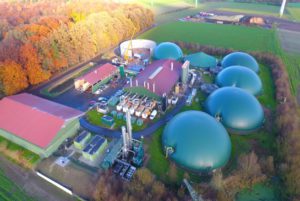BENAS, Germany (Demonstration plant)

Visit their website, see the factsheet , explore an illustration of the technology, process and products and watch the video.
Plant description: BENS (Ottersberg, Germany) yearly treats 87 000 to 100 000 tonne of energy crops (maize and corn) and poultry manure producing green gas, electricity and biobased fertilisers. They own 3,500 ha of agricultural land on which they apply the biobased fertilisers and cultivate energy crops. Poultry manure is rich in nitrogen and this demands control of ammonia levels in the digester to prevent ammonia inhibition for which they invested in a novel nitrogen (N) stripper. The use of energy crops as feedstock enables them to recover high-grade organic fibres from digestate. Within SYSTEMIC, they demonstrated their novel N stripper and developed a new market for the organic fibres.
Innovation: G (Halle), an engineering company and partner of SYSTEMIC, invented a novel N stripping- and recovery unit. In this approach, ammonia and carbon dioxide are stripped from digestate without chemicals and thereafter brought into contact with gypsum to form ammonium sulphate and calcium carbonate. Digestate leaving the N-stripper is separated by means of a screw press to recover organic fibres with a low ammonium content. The remaining digestate is fed back to the main digester. In 2021, BENAS invested in a fibre moulding and paper making machine for on-site production of, amongst others, biodegradable mulch mats and pots.
Mass- and Energy balances
- Biogas production per tonne of feedstock is highest among SYSTEMIC demo plants (236 m3/tonne in 2020) due to intake of energy crops. Biogas is upgraded to green gas (42 000 MWh/y in 2020) and electricity (28 000 MWh/y in 2020) for the national grid. BENAS acts as a grid-stabiliser meaning that electricity production is demand-driven.
- The N stripper recovered 56 to 85% of ammonium contained in digestate producing up to 4 000 tonnes of ammonium sulphate per year. Fibre production capacity amounts to 8 000 tonnes dry matter per year.
- No other chemicals than gypsum (a side product from coal-fired electricity plants) are used to absorb ammonium.
End-products & Agronomic quality:
- The process produces an ammonium sulphate solution (45 g N/kg, 58 g S/kg) that is in Germany recognised as an alternative for synthetic N fertilisers. Farmers should be aware of the high sulphur content of the product and adjust the application rate accordingly in order to prevent leaching of sulphate.
- Digestate is applied on their own fields. Nitrogen stripping lowers the N content of the digestate allowing a higher dosage within the N application limit (170 kg N/ha).
- The organic fibres are processed into paper products, pots and mulch mats and marketed under the brand name ‘Magaverde’. The fibres are FiBL-certified and can thus be used in organic agriculture.
Environmental benefits: High biogas production and low chemical consumption contribution avoid CO2 emissions. The use of energy crops (maize and corn) for energy production is under debate. BENAS could improve its CO2 footprint by switching towards treating of plant residues and biowaste rather than energy crops. Feedstock may however impact the quantity and quality of the recovered fibres.
Business Case: BENAS creates maximum revenues from biogas due to their flexibility in producing electricity as well as green gas. GNS and BENAS have also successfully developed the “Magaverde” brand, covering a range of fibre-derived and biodegradable products for consumers and wine producers. These products represent a much higher value per tonne than recycled fertilising products.
Outlook: BENAS will increase the production of organic fibres and products thereof. Market development is yet an ongoing activity.

